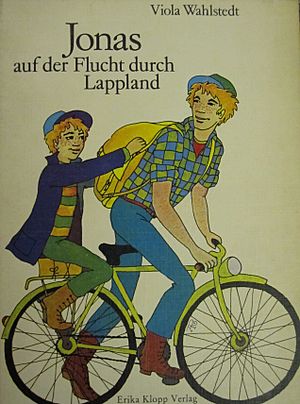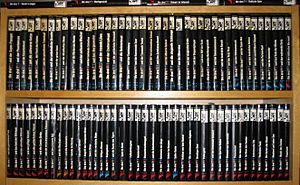Aiga Rasch facts for kids
Quick facts for kids
Aiga Rasch
|
|
|---|---|

"Lapathia", 2008
|
|
| Born | 9 July 1941 |
| Died | 24 December 2009 (aged 68) |
| Occupation | Illustrator Graphic artist Painter |
| Spouse(s) | 1. Manfred Naegele 2. |
| Parent(s) | Bodo Rasch (1903–1995) Lilo Rasch-Naegele (1914–1978) |
Aiga Rasch (born July 9, 1941 – died December 24, 2009) was a talented German artist. She was known for her work as an illustrator, a graphic artist, and a painter. She became especially famous for designing the covers of the popular "Three Investigators" book series in Germany.
Contents
Aiga Rasch's Early Life and Family
Growing Up with Art
Aiga Rasch was born in Stuttgart, Germany, during World War II. Art was in her family! Her father, Bodo Rasch, and her younger brother, Mahmoud Bodo Rasch, were both architects. Her mother, Lilo Rasch-Naegele, was a well-known fashion photographer and illustrator.
Aiga started painting when she was very young. After the war, toys were hard to find. So, her mother gave her a brush and paints instead. Even though the paint tubes were sometimes too hard for her small fingers, she loved to create.
She grew up in a house her parents built near Stuttgart. Aiga first thought she might become a writer. She enjoyed school, especially the meals, which came from the American army kitchens. Before finishing school, she entered a writing contest. She even included her own drawings! This led to her working with Kosmos Verlag, a publishing company her mother also worked for. This was the start of a long and successful partnership.
Choosing a Career Path
After high school, Aiga went to the University of Tübingen. She studied German, Philosophy, and Psychology. She wanted to avoid working in the same field as her mother. She even thought about becoming a journalist.
During a summer break, she volunteered at a company newspaper. There, her drawing skills were noticed again. In 1961, she decided to stop her studies. She then got married for the first time.
In 1962, she tried to get into the State Academy of Fine Arts in Stuttgart. But a teacher told her that her art was too much like her mother's. He suggested she would do better learning on her own. Aiga followed this advice, and it worked out well! She later said that being her mother's daughter was both helpful and a bit tricky when she was starting out.
Becoming a Professional Artist
In 1963, Aiga Rasch started her career as an independent graphic artist. Even though she didn't have formal art school training, she had a strong family background in art. Her grandfather painted flowers, and she learned a lot from her mother's work.
She joined a magazine and learned about page design. She was also a member of the West German Association of German Graphic Designers (BDG) for many years. She even served on its executive board. Later, she became the chair of the BDG's regional group in Baden-Württemberg.
In 1980, Aiga spent a year in Colorado, USA. She learned Zen meditation, Tai chi, and a bit of Kung fu. This experience changed her life and her art. She started using watercolors more and focused less on just designing book covers. After 1992, she began using computers for most of her work.
The Famous "Three Investigators" Covers
Aiga Rasch became very famous for her amazing cover designs for the German children's book series "Die drei ???" (which means "The three question marks"). In English, this series is known as the "Three Investigators". These books were first translated from American English. In Germany, they became super popular, partly because of Aiga's unique and unforgettable covers.
She had been working for Kosmos Verlag since 1962, illustrating books for kids and teens. In 1969, she saw the first two "Three Investigators" books. She felt their covers didn't stand out enough. So, she created her own designs and showed them to the publishers. At first, they weren't sure. Aiga even offered to give up her fee if her designs didn't sell well!
Finally, they let her design the cover for the third book, "Flucht des Rubins" ("Flight of the Ruby"). In 1970, she presented her design as a collage using only red, white, and black. Later, she switched to full-color designs, even using new felt pens. A cool thing about her covers was that the main characters never appeared on them. This allowed readers to imagine the characters themselves!
The original American series only had 43 books. But in Germany, "Die drei ???" became so popular that Kosmos published 89 books between 1970 and 1999, all with Aiga Rasch's covers! She also redesigned 16 covers for older books. Even after she retired, she continued to work for Kosmos from 2006, creating new digital cover designs.
Aiga Rasch's designs weren't just for books. After 1979, her "Three Investigators" covers were also used for "Talking Books" (audiobooks). Including re-issues and audiobooks, more than 30 million copies featuring her cover designs have been sold in Germany alone! Her famous "Three Investigators" logo was also used in China, Greece, and Russia.



